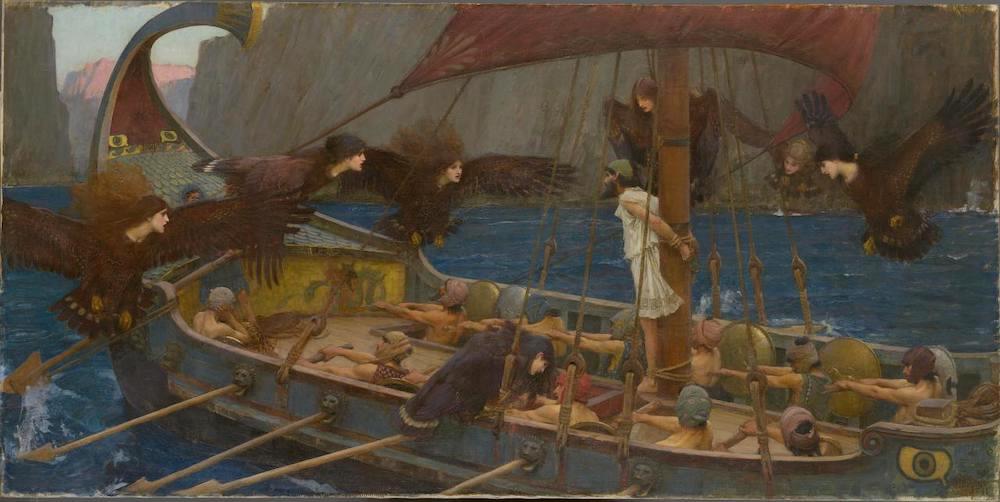In the mid 1880s, having mastered the realistic classicism style of Alma-Tadema, John William Waterhouse began painting in a romantic fashion resembling third-generation PreRaphaelites. Four paintings — Ulysses and the Sirens (1891), Circe Offering the Cup to Odysseus (1891), Penelope and the Suitors (1912), and Sketch of Circe (c.1911-14) — exemplify the shift in style that lasted for more than two decades. Whereas earlier works such as Consulting the Oracle (1884) or Saint Eulia (1985) revelled in exquisite detail, later paintings became more abstract, resembling, ironically, some of Waterhouse's earliest paintings such as Sleep and his Half-Brother Death (1874).


(left) Ulysses and the Sirens (right) Circe Offering the Cup to Odysseus.
Although Waterhouse's style remained consistently romantic after 1890, a comparison his Homeric paintings (above) indicate that his attitude towards women may have changed. Specifically, Ulysses and the Sirens and Circe Offering the Cup to Odysseus depict dangerous femme fatales; Penelope and the Suitors and Sketch of Circe , by contrast, present obedient or subdued female models. It seems that if women had once struck Waterhouse as menacing and mysterious, they eventually ceased to threaten him, at least in his artwork.
Waterhouse's change in attitude is evident in the contrasting ways he chose to paint his female subjects. Though the women in Ulysses and the Sirens are depicted as grotesque winged creatures, they nevertheless captivate the wandering Greeks with seductive beauty. One sailor sitting to the left of Ulysses appears fascinated not disgusted by the temptress perched on the gunwale. Few of his compatriots stare ahead with the resilience of their captain; instead, they gaze curiously upon the mysterious bird-women.
The motif of dangerous power and beauty is more explicitly displayed in Circe Offering the Cup to Odysseus . Here the seductress offers destructive wine to Odysseus as he approaches with obvious caution. A transparent dress hangs skimpily over her body and her breasts are made more pronounced by raised arms. She beckons Odysseus with a longing, almost submissive look. Since Circe combines physical beauty with raw sex appeal, her power is doubled. Even though the hero does not succumb to temptation in either painting, Peter Trippi argues the femme fatale threat is a more prominent theme than resistance, especially since both images of Odysseus resemble Waterhouse himself. "Although it cannot be proved," he writes, "this physical resemblance suggests that Waterhouse identified with Odysseus as a man who struggles to know the secrets of artistic and female beauty" (110).
The spectre of secret female beauty that haunted many of Waterhouse's male contemporaries and was so prominent in his early Homeric works appears to have subsided by 1910. In Penelope and the Suitors, Waterhouse's female ceases to be the seducer and is instead solicited by an army of suitors. Of course, Waterhouse was sticking to the storyline, but his presentation of Penelope and her maids nevertheless contrasts greatly with the women we saw before. Though not unattractive, Penelope and her assistants have no explicit sexual appeal. They do not wear revealing dresses or direct their gazes at the onlooking men.
The contrast is more significant in his Sketch of Circe. Having been abandoned by Odysseus, the once powerful but now melancholic vixen faces a menagerie of transformed captives. A cup similar to the one she first offered Odysseus lies defeated on its side, contents spilled on the table. An open alchemy book together with her mood indicates that she has failed as a seductress. In fact, the painting is hardly sexual at all. Her dress leaves little skin exposed and her arms remain close to her body. If anything, Circe and hence the femme fatale appears impotent, so much so that the sea-witch now seems vulnerable to her male viewers.
Although Waterhouse's later paintings honor The Odyssey's storyline, they reject the threatening secrets of female beauty displayed so prominently in his earlier works.
Questions
1. Do you think it is a coincidence that Waterhouse painted Ulysses and the Sirens and Circe Offering the Cup to Odysseus together in 1891, and Penelope and the Suitors and Sketch of Circe together some twenty years later?
2. Waterhouse uses two different models in his Circe paintings. How do they differ physically and what might that suggest? Pay special attention to their hair, dresses, and pose.
3. Ulysses and the Sirens is noticeably more romantic than the other paintings. Why might this be so?
Bibliography
Trippi, Peter. J. W. Waterhouse. London: Phaidon, 2002.
Last modified 19 April 2007